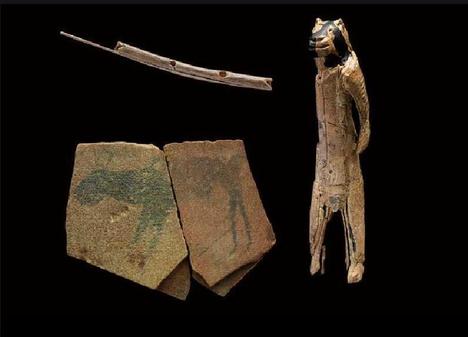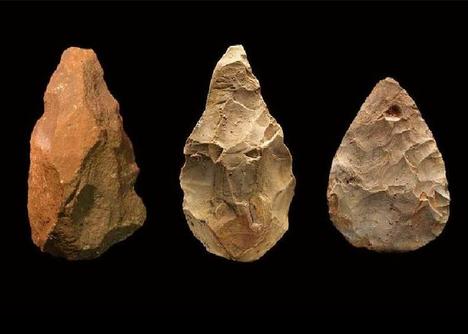 “Early Homo sapiens created these symbolic objects between 60,000 and 30,000 years ago. Using natural materials and creativity, they combined animal and human features into fantastical creatures and fashioned instruments for making music. “Source of caption and photo: online version of the WSJ article quoted and cited below.
“Early Homo sapiens created these symbolic objects between 60,000 and 30,000 years ago. Using natural materials and creativity, they combined animal and human features into fantastical creatures and fashioned instruments for making music. “Source of caption and photo: online version of the WSJ article quoted and cited below.
The sort of artifacts displayed above have been used to argue that homo sapiens had essentially reached their modern capabilities at least by 40,000 years ago.
The handaxes below are fascinating, in that they clearly display progress, and they clearly display how slow that progress was.
(p. D13) The mysterious Ice Age extinction of the Neanderthals, losers in the competition against modern humans, still fires the popular imagination. So it’s startling to learn that as recently as 70,000 years ago, at least four human species coexisted, including tenacious, long-lived Homo erectus and diminutive, hobbit-like Homo floresiensis, found in Indonesia in 2003.
The sensational 1974 discovery in Ethiopia of “Lucy,” resembling an ape but walking upright, located human origins 3.2 million years in the past. Those same fossil deposits have recently yielded even more-ancient ancestors, who stood on their own two feet as far back as six million years ago.
Paleoanthropology is thriving, and human fossil finds–more than 6,000 and counting–regularly force revisions of old timelines and theories. Our species, Homo sapiens, turns out to have had an abundance of long-lost cousins, though scientists are still arguing about the closeness of those relationships. The new David H. Koch Hall of Human Origins at the Smithsonian National Museum of Natural History, whose opening marked the museum’s centennial, provides a formidable overview of this still-developing story.
. . .
It’s long been accepted that different human species were adapted to thrive in specific climatic niches. Neanderthals had short, compact bodies to conserve heat and large nasal passages to warm frigid air, while some of our African forebears had long, skinny frames suited to hotter climes. But this exhibition contends that the evolutionary concomitant of incessant climate change was human resilience–the flexibility to make it almost anywhere, thanks to large, sophisticated brains and social networks.
Versatility apparently characterized even our oldest relatives. The ability to walk upright through the drier, more open grasslands did not immediately divest them of their penchant for climbing trees in the shrinking woodlands. A diorama of Lucy (Australopithecus afarensis) depicts her with one foot on the ground and another on a tree limb, symbolizing her straddling of two environments.
For the full review, see:
JULIA M. KLEIN. “Natural History; Our Species Rediscovers Its Cousins.” The Wall Street Journal (Tues., May 11, 2010): D13.
(Note: ellipsis added.)
 “Handaxes — multipurpose tools used to chop wood, butcher animals, and make other tools — dominated early human technology for more than a million years. Left to right: Africa (1.6 million years old), Asia (1.1 million years old), and Europe (250,000 years old).” Source of caption and photo: online version of the WSJ article quoted and cited above.
“Handaxes — multipurpose tools used to chop wood, butcher animals, and make other tools — dominated early human technology for more than a million years. Left to right: Africa (1.6 million years old), Asia (1.1 million years old), and Europe (250,000 years old).” Source of caption and photo: online version of the WSJ article quoted and cited above.

